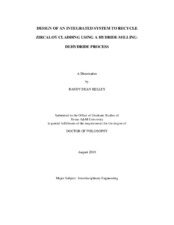| dc.description.abstract | A process for recycling spent nuclear fuel cladding, a zirconium alloy (Zircaloy), into a metal powder that may be used for advanced nuclear fuel applications, was investigated to determine if it is a viable strategy. The process begins with hydriding the Zircaloy cladding hulls after the spent nuclear fuel has been dissolved from the cladding. The addition of hydrogen atoms to the zirconium matrix stresses the lattice and forms brittle zirconium hydride, which is easily pulverized into a powder. The dehydriding process removes hydrogen by heating the powder in a vacuum, resulting in a zirconium metal powder.
The two main objectives of this research are to investigate the dehydriding process and to design, build and demonstrate a specialized piece of equipment to process the zirconium from cladding hulls to metal powder without intermediate handling.
The hydriding process (known from literature) took place in a 95 percent argon - 5 percent hydrogen atmosphere at 500 degrees C while the dehydriding process conditions were researched with a Thermogavimetric Analyzer (TGA). Data from the TGA showed the dehydriding process requires vacuum conditions (~0.001 bar) and 800 degrees C environment to decompose the zirconium hydride.
Zirconium metal powder was created in two separate experiments with different milling times, 45 minutes (coarse powder) and 12 hours (fine powder). Both powders were analyzed by three separate analytical methods, X-Ray Diffraction (XRD), size characterization and digital micrographs. XRD analysis proved that the process produced a zirconium metal. Additionally, visual observations of the samples silvery color confirmed the presence of zirconium metal.
The presence on zirconium metal in the two samples confirmed the operation of the hydriding / milling / hydriding machine. Further refining of the hydride / milling / dehydride machine could make this process commercially favorable when compared to the high cost of storing nuclear waste and its components. An additional important point is that this process can easily be used on other metals that are subject to hydrogen embrittlement, knowing the relevant temperatures and pressures associated with the hydriding / dehydriding of that particular metal. | en |


